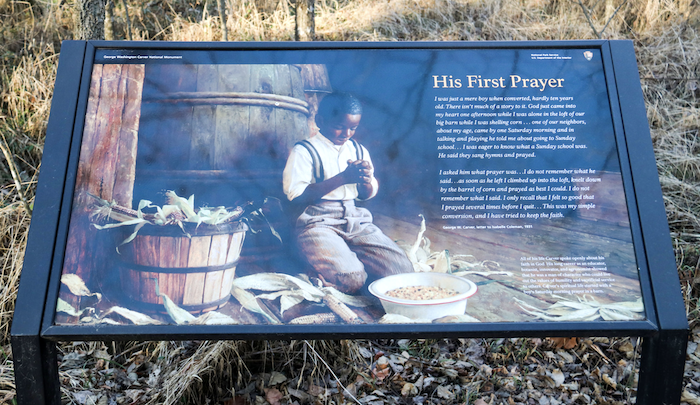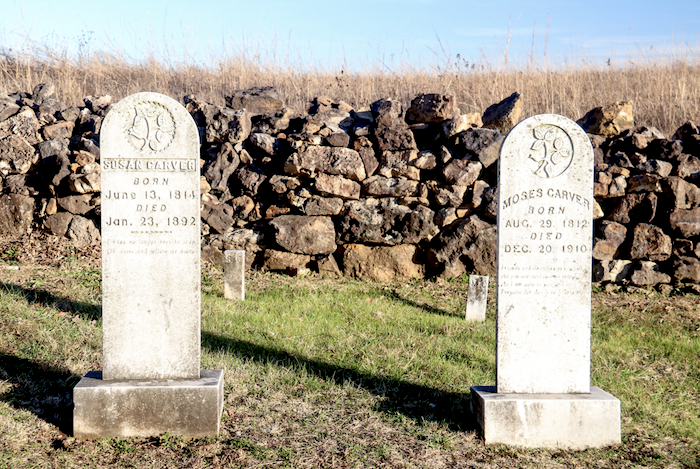Statue of George Washington Carver as a boy at the entrance to the Carver Trail/Robert Amendola via NPS
Walking With George
By Robert Pahre
When people ask me about visiting a national park, especially one of the historic sites, I usually recommend starting with the visitor center. But I will make an exception today. When you go to George Washington Carver National Monument in rural southwestern Missouri, start with the nature trail.
The Carver Trail begins at a trailhead next to the parking lot. It takes you through the woods and stream bottoms that George explored as a young boy. These lands made George curious about the way the world works, inspiring his interests in both science and art. He learned about plants and even built a hidden garden. The park tries to leave this natural environment alone, though the trail will lead you along some modern fields outside the park.
Since George was born enslaved, you might wonder how he found time to explore the woods. Apparently, he was too frail for field work, so Susan Carver assigned him the task of drawing water from the creek. He lingered. He learned to look closely at plants and to ask questions about them. He collected rocks and thought about their colors. Both plants and pigments shaped his painting, and these woods clearly influenced the ideas behind his art. One of his paintings, Yucca and Cactus, won an honorable mention at the Chicago’s World Fair—but he would set aside the idea of a career in art in favor of science.

George Washington Carver says his first experience with God was while shelling corn/Robert Pahre
As you read the signs along the trail, you might begin to wonder some things about George that don’t quite add up. For example, there are different stories about his mother, his sister, George, and the Civil War. The park relies heavily on Carver’s adult memories of his childhood; like many childhood memories, they romanticize some things and leave some other things out. He also seems to have hidden some things about his past. His most recent biographer, Christine Vella, discovered what she could about an extended romance, a hostile work environment at the Tuskegee Institute, and some other matters—but George remains a bit of an enigma.
The nature trail also introduces some ideas that will help you understand George better, such as his first prayer. God came into George’s heart one afternoon when he was alone in a barn loft, shelling corn. George later said that the experience had felt good, and that he had done his best to keep the faith. While at the Tuskegee Institute, George Washington Carver took a devotional walk early each morning, and expressed his faith during the day through his science, his outreach, and his love and kindness toward other people. Telling this kind of story of faith is unusual in the national parks.
After walking with George, you pass by the cemetery where his enslavers, Moses and Susan Carver, are buried. He seems to have viewed them as parent figures, and in some ways they viewed him as the child they never had. They supported his education, at least for a while. After that, some teachers and professors saw George’s potential and helped him even further along.

George Washington Carver seemed to regard Moses and Susan Carver as parent figures/Robert Pahre
From the cemetery, you arrive at the visitor center. It includes a reproduction of his classroom lab at the Tuskegee Institute that is surely much cleaner than the real one could ever have been. The visitor center also tells the rest of George’s life story. He achieved many firsts—the first African American to earn a bachelor’s degree at what is now Iowa State University, the first to earn a master’s degree there, and the first to become a professor there. Those who know his name today associate him with innovative uses for peanuts, reflecting his careful approach to applied agricultural science. He hoped that finding many uses for a low-value crop that grows well in the South would free his people from growing cotton.
Like many historical sites, the visitor center tends to celebrate its subject. For a more complex view, I recommend Christine Vella’s biography, for sale in the park store. She gives a fuller picture of a man who successfully navigated the role of a “model” Black man in the Jim Crow South, entering hotels through the kitchen door on his way to deliver a keynote speech. She also tells of how Carver remained inexplicably loyal to Booker T. Washington and the Tuskegee Institute, even though Booker treated him poorly. She also tries to understand George’s thinking as he turned down opportunities to join universities with better resources, or to have Henry Ford fund a laboratory of his own.
The visitor center suggests that those decisions simply reflected the faith of “this humble man whose love of God and agriculture became a ministry to benefit humanity.” George Washington Carver did not seek material success. He refused speaking fees and did not patent his inventions. Instead, he sought to help his people by sharing what he learned, through outreach to the community and by teaching his students.
The simplicity and innocence of George’s decisions will linger as you leave the visitor center and return to the start of the nature trail, to the beginning of George’s life as a boy playing in the woods in Southwest Missouri.





